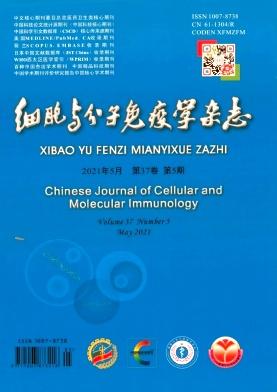[慢性阻塞性肺疾病继发性真菌性肺炎患者白细胞介素36γ升高对CD8+ T细胞功能的调节作用]。
摘要
目的探讨白细胞介素36γ (IL-36γ)在慢性阻塞性肺疾病(COPD)继发真菌性肺炎患者中的表达,并分析IL-36γ对CD8+ T细胞活性的影响。方法采集47例慢性阻塞性肺病患者、39例慢性阻塞性肺病继发真菌性肺炎患者和20例对照组的外周血。对27例COPD继发真菌性肺炎患者进行支气管肺泡灌洗液(BALF)分离。纯化CD8+ T细胞。采用酶联免疫吸附法(ELISA)检测血浆和BALF中4种IL-36亚型的水平。重组人IL-36γ刺激CD8+ T细胞。ELISA法检测培养上清液中干扰素γ(IFN-γ)、肿瘤坏死因子α(TNF-α)、穿孔素和颗粒酶B的水平。重组人il -36γ刺激的CD8+ T细胞与NCI-H1882细胞通过直接细胞间接触或TranswellTM方式共培养。测定培养上清液中IFN-γ、TNF-α和乳酸脱氢酶的水平。计算靶细胞死亡百分率。结果COPD组及COPD合并继发性真菌性肺炎组血浆IL-36α、IL-36β、IL-36γ水平均显著高于对照组。COPD合并继发性真菌性肺炎组血浆IL-36γ水平高于COPD组[(200.11±99.95)pg/mL vs(53.03±87.18)pg/mL, P=0.023]。三组患者血浆IL-36受体拮抗剂水平差异无统计学意义。慢性阻塞性肺病合并继发性真菌性肺炎感染部位BALF中IL-36γ水平高于非感染部位[(305.82±59.60)pg/mL vs(251.93±76.01)pg/mL, P=0.011]。IL-36γ刺激可增强CD8+ T细胞分泌的IFN-γ、TNF-α、穿孔素和颗粒酶B。il -36γ刺激的CD8+ T细胞与NCI-H1882细胞直接混合共培养时,细胞死亡率升高[(16.06±3.67)% vs(11.47±2.36)%,P=0.002]。使用TranswellTM板非接触共培养时,il -36γ刺激CD8+ T细胞介导的NCI-H1882细胞死亡与未刺激时差异无统计学意义[(4.77±0.78)% vs(4.99±0.92)%,P=0.554]。结论慢性阻塞性肺病合并继发性真菌性肺炎患者血浆及感染部位IL-36γ水平升高,增强了外周血和感染微环境中CD8+ T细胞的细胞毒性。Objectives To investigate interleukin 36γ (IL-36γ) expression, and analyze the influence of IL-36γ to CD8+ T cell activity in chronic obstructive pulmonary diseases (COPD) patients with secondary fungal pneumonia. Methods Peripheral blood was collected from 47 COPD patients, 39 COPD patients with secondary fungal pneumonia, and 20 controls. Bronchial alveolar lavage fluid (BALF) was isolated from 27 COPD patients with secondary fungal pneumonia. CD8+ T cells were purified. The levels of four IL-36 isoforms in plasma and BALF were measured by enzyme linked immunosorbent assay (ELISA). CD8+ T cells were stimulated with recombinant human IL-36γ. The levels of interferon γ(IFN-γ), tumor necrosis factor α(TNF-α), perforin and granzyme B in the cultured supernatants were measured by ELISA. Recombinant human IL-36γ-stimulated CD8+ T cells were co-cultured with NCI-H1882 cells in either direct cell-to-cell contact or TranswellTM manner. The levels of IFN-γ, TNF-α, and lactate dehydrogenase in the cultured supernatants were assessed. The percentage of target cell death was calculated. Results Plasma IL-36α, IL-36β, and IL-36γ levels were significantly elevated in both COPD group and COPD with secondary fungal pneumonia group compared with those in control group. However, only plasma IL-36γ level was higher in COPD with secondary fungal pneumonia group than that in COPD group [(200.11±99.95)pg/mL vs (53.03±87.18)pg/mL, P=0.023]. There was no remarkable difference in plasma IL-36 receptor antagonist level among three groups. IL-36γ level in BALF from infectious site was higher than that from non-infectious site in COPD with secondary fungal pneumonia group [(305.82±59.60)pg/mL vs (251.93±76.01)pg/mL, P=0.011]. IL-36γ stimulation enhanced IFN-γ, TNF-α, perforin and granzyme B secreted by CD8+ T cells. When IL-36γ-stimulated CD8+ T cells were directly mixed with NCI-H1882 cells for co-culture, the percentage of cell death was increased [(16.06±3.67)% vs (11.47±2.36)%, P=0.002]. When using TranswellTM plate for non-contact co-culture, IL-36γ-stimulated CD8+ T cell-mediated death of NCI-H1882 cells showed no significant difference compared to that without stimulation [(4.77±0.78)% vs (4.99±0.92)%, P=0.554]. Conclusion IL-36γ level in plasma and infectious site is elevated in COPD patients with secondary fungal pneumonia, which enhances the cytotoxicity of CD8+ T cells in peripheral blood and infectious microenviroment.

 求助内容:
求助内容: 应助结果提醒方式:
应助结果提醒方式:


